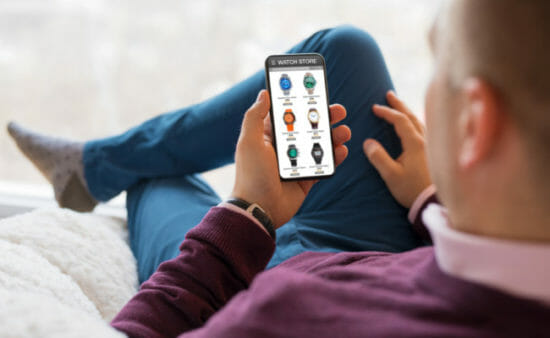7 SEO Best Practices for Mobile in 2022
If you’re looking for the best practices for mobile SEO, you’ve come to the right place! We will show you how your website can look and perform at its best on smartphones. In turn, it’s ready to serve potential customers wherever and whenever!
We will go through mobile search engine optimization best practices one by one. However, we know that not every reader will be familiar with this topic. That’s why we reserved a segment elaborating on mobile SEO below.
Almost everyone is a mobile user. Mobile devices allow us to browse the internet no matter the time and place. If you have a website, you must ensure it will appear correctly and beautifully on these devices. As a result, it will leave a great first impression on all visitors.
To guide you keep your online store or website optimized for today’s mobile search traffic, we’ve put together a in depth research article on how to use SEO mobile best practices to keep your website ranking!
- Why is mobile SEO so important to generate traffic?
- Why mobile SEO is so important?
- What is mobile optimization?
- What are the 7 best practices for you to optimize your website for mobile users?
What is Mobile SEO Practices?
The practice of improving mobile websites to display correctly and operate well on mobile devices is known as mobile search engine optimization. It assists you in achieving higher organic mobile traffic and a higher ranking in search engine result pages (SERPs).
Importance of Optimization of Mobile Site
The internet has been around for several years. Even then, people have been making sure their website got picked up by Google searches. How were they doing it? Website creators focused on desktop optimization back then. After all, mobile devices weren’t around decades ago. That all changed when smartphones launched.
Soon, more people gained access to mobile devices. Gone were the days when many desktop users sat at their tables before going online. Most advantages of mobile optimization may appear evident in a world where most people conduct mobile searches on their devices.
We can’t discuss mobile optimization without understanding why local SEO is essential for your company. People are growing more demanding regarding the products and services they want. Every year they anticipate more localized solutions that meet their specific requirements.
There are numerous reasons you should start paying more attention to mobile optimization, but we’ve highlighted the most important ones. Below are the most significant benefits of mobile SEO.
Searches on mobile devices continue to rise.
First and foremost, it is about the overall market trend. Mobile searches have surpassed desktop searches for some time, and this trend will continue. According to statistics, there are more mobile visitors to mobile sites than desktop users who search on the web.
Mobile optimization results in higher search engine ranks. Google analytics or algorithm now favors mobile-friendly websites. So, keep mobile SEO in mind if you want your website to rank higher in Google’s mobile-first index searches.
Because of this shift in the tides, even if a person uses a desktop version of a search engine, your website will rank lower in desktop search results if it is not optimized for mobile users. That means many of your target clients will likely find your content on mobile devices. They’ll be able to do so if the mobile SEO strategy improves.
Positive experiences on-site encourage mobile users to return.
If you have a good experience on a mobile website, you are much more likely to return to it later. Concentrate on getting mobile visitors to return to your mobile site. This strategy increases the likelihood of them becoming clients for your company.
People with a bad mobile site experience will have an unfavorable perception of your offerings and leave your pages. You can avoid this drop in your mobile search rankings.
Conversion rates are affected by mobile SEO.
If you have a mobile-friendly website and your website functions effectively on a mobile device, your target audience will likely buy your items and use your services. Mobile content optimization will result in more conversions for your business.
Search on a mobile device increases sales.
Mobile device usage fuels pre-sale mobile searches. Mobile users are looking for product reviews online utilizing their phones. Customers are more likely to click on your link if you use the right mobile search terms to direct them to you.
Because so many internet users choose to study products or services on their mobile devices, carefully crafted mobile SEO can help you reach your target and give them a pleasant user experience.
Mobile-First Indexing: Determine ranking by mobile content.
Google’s algorithm now favors mobile-optimized content. It shifted to a mobile-first indexing strategy. Websites that do not focus on mobile SEO in 2022 are more likely to be ignored by Google and other search engines. This procedure can result in decreased mobile traffic, fewer leads, and a decrease in your company’s revenue.
Your brand needs a good mobile Users Experience.
We said mobile version SEO could make or break your first impression with customers. Many of them will first encounter your brand on their mobile devices. Website visitors will have a quick and efficient experience if a website is mobile-friendly.
And that’s what they’re looking for because they’re not conducting the in-depth searches seen on a desktop version. Rather, they do mobile searches while moving or multitasking. You cannot overstate the value of simplicity and accessibility.
Mobile device sales are growing.
In 2020, more than 2 billion people will buy products and services on the internet. Meanwhile, e-retail sales went beyond 4.2 trillion US dollars around the world. If you’re providing goods and services online, these should convince you to use the best practices for mobile SEO.
Voice search and local mobile SEO.
When customers ask Alexa or Siri for an item, your brand should be the first thing they recommend. Mobile SEO’s best practices may also help with local SEO.
More businesses create a mobile-friendly websites.
With individuals exploring the internet in droves for the services they require, it’s clear that businesses that did not build their mobile SEO strategy to improve their mobile traffic and aren’t visible on SERPs will not expand as quickly as others. Visitors will stay longer on a responsive site optimized for their screens or a mobile-friendly site. As a result, businesses that have more visitors to their website’s mobile version are more likely to generate money.
7 Mobile SEO Practices Checklist
Knowing why mobile optimization is important isn’t enough. You should educate yourself on the best mobile optimization approaches for adapting your content to mobile consumers. Let’s look at some amazing methods for mobile optimization of your site. Below is a checklist on how to optimize your site for mobile users.
Prepare your Mobile SEO configuration.
In 2018, we had Google’s mobile-first index. It’s where the search engine stores all the data collected from websites. This method uses indexing to understand the information. This type of index is used for the entire web nowadays. In response, people configured their websites by choosing among three methods:
- Separate site: The earliest website configuration method was to create two different site versions. One was for desktops, while the other was for mobile devices. As you can imagine, this took a lot of time and effort. However, some companies have preferred not to use the newer website configuration.
- Dynamic serving: Your website will have a single URL that will direct visitors to compatible versions with their devices. Imagine building a webpage for every smartphone model and screen size! However, this also took a lot of time and effort.
- Responsive web design: This web design involves just one URL with a single website that adapts to whatever device a visitor is using. This design is the one that Google prefers the most. Using it will allow you to rank higher on its search results. They also load faster, improving the user experience even more.
Are you wondering why websites still use the two older methods? Transitioning from one web configuration to another takes time, effort, and money. Weigh your options carefully. Make sure you balance expertise and expense. Get the best digital marketing agency for the job for the best results.
Test all your website’s pages for Mobile SEO Optimization.
There are various web pages on your website. Each one has the potential to make or destroy the user experience. That is why you should double-check each page on your website. You may also do it for free! The tools you require are available in Google Search Console. Here’s how it can assist you in testing web pages:
- Navigate to the Google Search Console.
- Find the “Mobile Usability” button. This step will display the menu for viewing your site’s visitors’ results.
- Examine the outcomes. If there are any problems, the Console will notify you and walk you through the methods to resolve them.
Alternatively, you can enter your website’s URL into the Google Mobile-Friendly Test Tool. It’s quite easy to use. It has the appearance and functionality of Google’s homepage. You should still visit the websites on your own. Just be certain it has nothing to do with your company. In other words, you should not relate it to the instruments used by your firm.
You may install apps or cookies specific to that site on your corporate phone or computer. Outside of your company, your user experience may not be the same. Meanwhile, a random device will show how regular people see your website. Still, you shouldn’t just stick to one method. Use several of the best practices for mobile SEO instead.
Let the bots crawl your website
We often refer to the internet as a sort of “web.” It contains billions of online resources that are all connected. Following this analogy, it also has “spiders” crawling all over! Specifically, search engines like Google use search spiders. These are the ones that perform the indexing we mentioned. They establish connections between the various sites.
You may not like real-life spiders, but you should embrace these online ones. In other words, you should allow them access to its resources. Allow them to learn more about your site. These online spiders will make it easier for search spiders to add your site to the Google Index. They’ll have an easier time “crawling” all over your website. You may perform one of these steps:
- Check robots.txt: Open this file to see if it’s allowing search spiders. Enter your homepage URL followed by “/robots.txt.”
- Google Search Console: Open the Console. Then, look for the Google Index section in the robots tab. Click on it and then check the Blocked Resources. Alternatively, ensure search spiders can access everything via the Fetch and Render tool.
- Create an XML sitemap: After making the sitemaps, please send them to the Google Search Console and your mobile website.
Your website should load quickly.
Let’s say your website allows online purchases. If it takes too long to load, people will likely leave you. A few seconds could significantly affect your bounce rate! A slow website can also interfere with lead generation. You’ll have difficulty getting information qualified leads if you load too slowly in mobile and desktop searches.
Let’s say a customer finally locked in their purchase. Sadly, it took too long to process the transaction. That’s a sales-qualified lead you lost right there! The customer might just leave. This aftereffect is why you should check your site speed. Google’s mobile speed test can help you. It’s a free online service that works like its other tools.
Moreover, accelerated mobile pages (AMP) is a good way to make your website load fast. Reduced-feature versions of websites created specifically to load rapidly on mobile devices are known as accelerated mobile pages. In actuality, AMP pages load roughly 4 times quicker than their non-AMP equivalents.
The mobile site speed test will tell you how fast your website loads. It will also show you how it performs with what connection. Similar to the mobile-friendly tool, it will provide solutions too. What’s more, use Mobile Analysis with Google Developers PageSpeed Insights. Then, run regular checks via the PageSpeed Insights analyzer tool.
It must also load correctly.
Let’s say your website now loads quickly. On some devices, though, you find out that the site looks wrong. This outcome could be due to poor web optimization. The parts of the website might show up in the bad segments. Or the text is too big that users have to adjust it themselves.
Such factors may turn off website visitors and increase your bounce rate. What are the best mobile SEO practices for this one? They’re similar to what you’d do for a desktop site. Here are some of the steps you could take:
- Make easy-to-use menus: Avoid showing the menu right on your website. Instead, provide a pull-down menu or toggle. Those will take away precious real estate for your content.
- Avoid pop-up windows: Google frowns upon using lightboxes or pop-up windows.
- Adapt screen size of mobile devices: This process means your website should adapt to the screen size of visitor devices. Dynamic serving or responsive web design may help with this.
- Provide easy search: Users should have an easier time accessing the search bar. Your search filters should reduce the chances of showing zero results.
- Place widgets: Have you ever seen a small button in the bottom right corner of websites? Click on those, and it will probably let you speak to a customer service representative. What’s more, there’s a home-shaped icon that takes you back to the homepage. You may want to add those to your website as well.
- A mobile-friendly website can contain aspects such as slideshows that run without Flash or text-based contact information that prompts email messages or calls via mobile devices.
- When you optimize a site for mobile devices, it will reformat itself for smartphones. Your website should look good on screen, but it should also be easy to use. That is why mobile optimization approaches reformat material, make navigation buttons more visible, and improve graphics.
Your website should be visually appealing.
Let’s say you’ve followed the best mobile SEO practices so far. Your site loads fast, and it’s easy to use, too. Yet, people may still not hang around on your site. Why is that?
People should also like how your website looks. Strike a balance between aesthetic and function. It should look pretty but not pretty hard to view! You can improve it by:
-
Writing brief paragraphs: Phones have limited screen space. You don’t want a huge wall of text blocking your entire website. Instead, break up paragraphs into smaller bits. If you’ve noticed, this article applies this mobile SEO method!
-
Using bullet points: It’s easier to show a list if you use bullet points. If you use a paragraph, they’ll clump together. In turn, the reader will have to strain hard for each line of text. Again, this article applies one of the SEO best practices!
-
Picking the right fonts: Fancy font to stand out among competitors may tempt you. However, readers may find it hard to read. Use a simple one like Arial instead. There are better ways to wow your audience.
- Choosing the right colors: You don’t want your page to look drab and dull. At the same time, it shouldn’t overwhelm the eyes with too many colors. You could keep it simple by using one color for the background. The text color should contrast with this.
Check your website analytics.
There is still one thing you should keep on doing after the best practices for mobile SEO. Constantly check your website’s performance. You can’t just call it a day and leave it be! The internet is always changing. It’s not just the Google search engine that’s updating.
The internet browsers and mobile phones do it too. As a result, your mobile-friendly website may not perform as well as it did before. That’s why you should keep up with the latest in tech. That way, you can redo the other mobile SEO methods properly.
Read More: How To Increase Your Domain Authority
Improve the meta titles and descriptions
When developing your mobile SEO strategy, don’t forget meta titles and meta descriptions. They determine whether or not a mobile user will click on your listing when it appears in SERPs. Because mobile users quickly scan their browsers for information, they will frequently check the meta title and meta description to decide whether to visit your website or continue scrolling.
- Meta Titles: Such titles will give potential visitors the first clues as to what to expect on your website. It’s a glimpse of your webpage critical for delivering more relevant mobile visitors to your website. To maximize your meta title, include your keyword in the title. This technique aims to inform customers that you provide relevant content.
- Meta Description: This description is a short sentence or two that appears beneath the meta title and provides mobile readers with further details about your page. It’s also good to let them know you have the mobile content for their needs. The idea is to be short and descriptive while staying inside the character limit (120-160 characters).
Conclusion
It’s evident that if you want strong rankings and conversion rates, you should focus on mobile optimization. An SEO audit can help you get started on the path to great mobile content optimization. While it’s normal to want to cram as much information and website features as possible, you must keep mobile user needs in mind.
Flaws in mobile optimization degrade the whole website experience – and your product or service suffers as a result. Follow our advice and keep an intuitive mentality to make adjustments that don’t need much work. If you optimize for mobile, you will improve for business and profitability.
Related Articles
FAQs
Why is mobile SEO important?
More mobile users are utilizing their gadgets instead of desktops to browse the internet. This reason is why you should be creating content tailored to these gadgets. That way, you’ll rank high on their search results. It will also allow you to improve the user experience and promote a positive brand image.
How can I improve my mobile SEO?
Your website should load properly on smartphones, regardless of brand or model. It shouldn’t take long to load, and visitors shouldn’t strain to view your site. Still, you need to follow desktop page SEO practices like internal linking. Make sure your anchor texts, alt texts, title tags, and meta descriptions suit Google analytics or search requirements.
What are SEO tools?
As the name suggests, these online services let you optimize content for search engines. You have free options such as the ones provided by Google. On the other hand, you may pay for SEMRush tools and others for better results. However, it’s best to use a combination of both.













